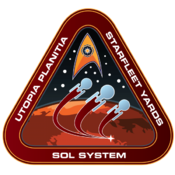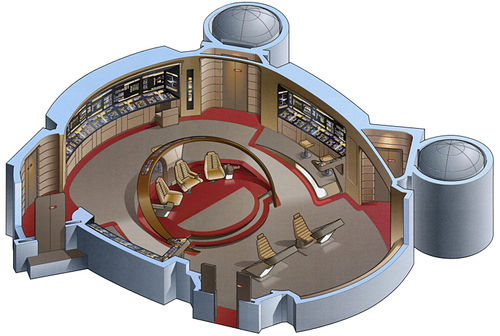|
EXPLORERS
Ambassador •
Cardiff •
Chariot •
Excelsior •
Excelsior II •
Galaxy •
Intrepid •
Juneau •
Luna •
Nebula •
Odyssey •
Sovereign •
Vesta

|
|
|
Galaxy Class Explorer
Commissioned: 2357
|
|
|
Saucer Separation
Building upon the concept of a true community in space pioneered by the Ambassador class, the Galaxy class specifications called for amenities not only for its officers and crew but their families and other civilians as well. In response to the safety concerns that accompanied such a large civilian contingent, designers at Utopia Planitia presented the Galaxy class as Starfleet's first starship with routine saucer separation capability. While previous starships had often included such a capability as an emergency procedure, the Galaxy class would be able to operate as two independent vehicles and then reunite without the need for a visit to a drydock or repair facility.
Class Modifications and Upgrades (2360s-2371)
The specifications for the Galaxy class during the 2360s were not substantially different from the "standard" configuration listed under the 2370s specifications in regards to propulsion and tactical performance. However, there were several key modifications and upgrades to the Galaxy class during this decade that were ultimately integrated into newer "uprated" vessels:
- After the launch of USS Galaxy, improved subspace field generators were introduced onto USS Yamato and USS Enterprise-D.
- Following the loss of USS Yamato in 2365 to a catastrophic antimatter containment failure, a complete systems review was undertaken to ensure there was no inherent design flaw. The review concluded that an Iconian software transmission was to ultimately blame for the ship's destruction but recommendations were also made to improve magnetic seal redundancy as well as ensure that revised primary and secondary backup systems were fully independent of main computer functions.
- The recommended matter/anti-matter ratio was decreased when performance data showed that too high a ratio diminished efficiency. Likewise, magnetic plasma transfer to the warp field generators was modified based on performance data.
- Original estimates of mean time between failures (MTBF, expressed in hours) were deemed unrealistic by chief engineers in the field, and a revised swap-out schedule for main component replacement was introduced.
- Originally intended to be introduced into the next class starship, a modification of the dilithium chamber was demonstrated in 2366 that made it possible to reorient the crystal. This modification was subsequently integrated into a new dilithium chamber design in 2367.
- A new innovation, the mid-range phase adjuster, was developed by G. La Forge, chief engineer of USS Enterprise-D. This device compensates for inertial distortion within drive plasma of the warp drive systems by putting the plasma back into phase,
- A new warp core was introduced in 2370, although initial manufacturing issues with contamination by interphasic organisms delayed wider implementation across the fleet. This new warp core allowed the Galaxy class to increase her top rated speed from warp 9.6 to warp 9.9 for 12 hours.
- Perhaps the most noticeable change for non-engineers serving aboard this class between the 2360s and 2370s was an upgrade of the main bridge introduced in the early 2370s. With Galaxy class vessels often serving as command units and mobile bases of operation, the bridge was expanded to include a dedicated communications suite on the port side and an augmented science suite on the starboard side.
|



